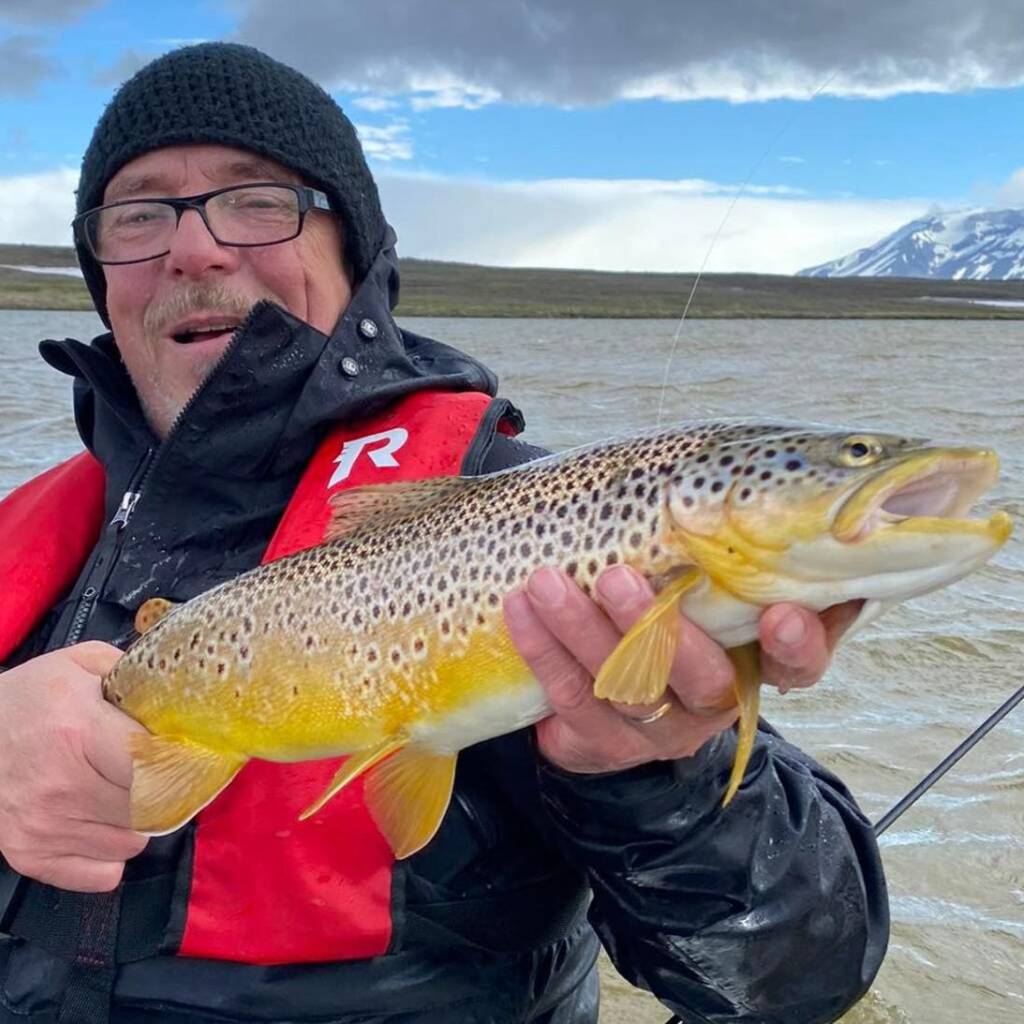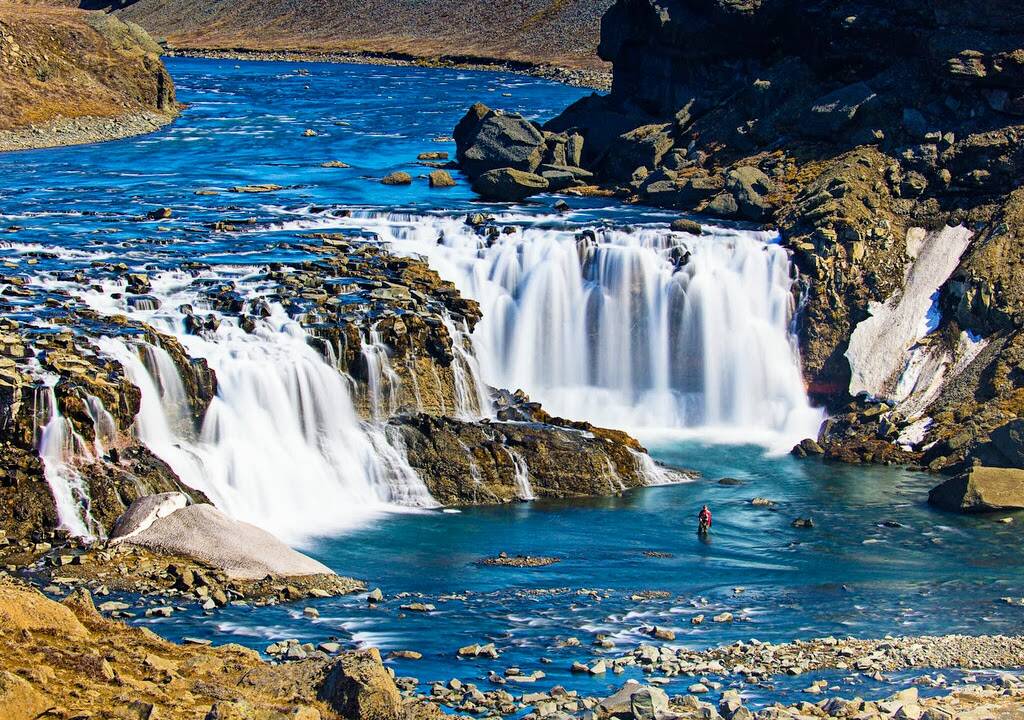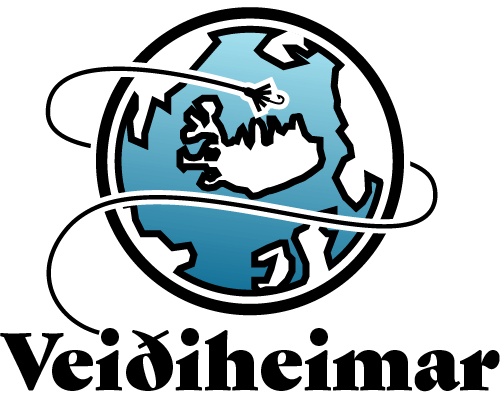Popular highland fishing in Iceland
The Icelandic highlands offer numerous fishing areas that attract anglers, many of which have gained popularity in recent years. One reason for their growing popularity is the rise in permit prices for salmon fishing, as well as for some sea trout and brown trout fishing. Nevertheless, some landowners and managers of popular highland fishing areas have exploited this change. Accommodation options have been enhanced, facilities improved, and roads and trails upgraded, leading to a slight rise in fishing license prices. This trend is more noticeable in well-known rivers compared to the numerous lakes in the areas.
The most popular lake areas are the following: Veiðivötn, Northern Arnarvatnsheiði, Southern Arnarvatnsheiði, Skagaheiði, and the Framvötn
Veiðivötn is considered the most productive fishing area in the country, comprising up to 50 lakes located in Landmannaafrétti. The largest lakes include Litlisjór, Grænavatn, Ónýtavatn, and Snjóölduvatn. Throughout history, the lake has been dominated by trout, a tradition dating back to the Ice Age. There is a significant presence of char in the lakes, with their numbers increasing in recent years. Since this is one of the most popular fishing spots in the country, fishing licenses tend to sell out quickly. There are various accommodations and top-notch facilities available. The Veiðivötn lake area is open from June 18th to August 20th. There are a hundred fishing rods available, and anglers can use any bait they prefer. It is recommended to be cautious driving regular cars on sandy sections; SUVs are preferable in those areas.
The northern area of Arnarvatnsheiði comprises approximately 15 lakes and is accessible from June 15th to September 15th. Many lakes have both trout and char, but the ratio of each species differs. The size of the fish varies from lake to lake, but you can find good catches in many locations. There is also good fishing in the rivers and streams that flow into and out of Stóra-Arnarvatn, such as Austurá, Geiraldslækur, and Skammá. Stóra-Arnarvatn can be reached on good SUVs, but a 4×4 jeep is necessary for further travel. Remember to bring a mosquito net. There are various accommodation options available.

The southern area of Arnarvatnsheiði has approximately 25 lakes and is open from June 10th to September 20th. Similar to the northern part, most of the lakes in this area are home to both trout and char. There are also several rivers and streams that flow between the lakes, offering excellent fishing opportunities. Note: The best way to reach the south side of Arnarvatnsheiði is by crossing a ford on the Norðlingafljót River, which is only accessible by jeep. There are various accommodations available, but they are more spread out in the southern region compared to the northern area.
On Skagaheiði, there are a few popular lake areas, the main ones being Hraun, Mallansvötn, Ketuvötn, and Hvalnes. These areas are characterized by lakes of different sizes with small rivers and streams flowing between them. Many of these lakes are great for fishing, offering opportunities to catch char and trout. Char are typically small in size, but some large ones can be found. Trout, especially in early spring, can be caught in good size. The Hvalnes area is popular and features 6 lakes, with the largest being Ölvesvatn. Cabins are available for rent in the area. Access to the lakes is restricted to 4×4 jeeps only.
The Malland area has recently become popular, especially since accommodations for 10 people have been made available. Like in the Hvalnes area, there are 6 lakes and streams flowing through the Malland area. There are plenty of trout and char available, but the number of rods is limited to eight. This area typically opens in early June, as do other areas, although it is occasionally possible to fish at Ölvesvatn in May. Before starting your journey, it’s advisable to contact the landowners and inquire about the road conditions leading to the lakes.
The most well-known highlands rivers are Norðlingafljót, Kaldakvísl, Tungnaá, Blöndukvíslar, and Austurá.
The River Norðlingafljót flows through Arnarvatnsheiði but is not connected to the lake area; it is a separate entity. In this river, you can find both Arctic char and brown trout, with the average size of the fish being on the larger side. The typical size of a brown trout ranges from two to six lbs, while Arctic char usually weigh between two and four lbs. Anglers are allowed to use up to four rods, with only fly fishing permitted.This is a dream area for upstream nymphing and dry fly fishing. The river is open from June 15th – August 31st and the area is only passable in 4×4 SUVs or jeeps.
Kaldakvísl is located in Holtamannaafrétt and runs into Sporðöldulón. It is home to a significant population of char, with the largest ones weighing up to 10 pounds. It is quite common to catch fish weighing 5-6 pounds. The area’s natural beauty is unmatched, featuring magnificent gorges, waterfalls, deep pools, shallow flats, and everything in between. The season runs from May 15th to September 30th. Four rods are allowed, and 4×4 Jeeps are the recommended choice for transportation.

The River Tungnaá is a short distance from Kaldakvísl. It originates from Sporðöldulón and flows into Hrauneyjalón. Similar to Kaldakvísl, the main fish found in the river is the resident Arctic char, with an average weight of about 3 pounds and it is not uncommon to catch fish weighing 5-6 pounds. The river is small, making it ideal for fishing with nymphs and dry flies. The fishing season runs from May 15th to September 30th. Only fly fishing is allowed, with a limit of four rods.
Blöndukvíslar is an area located above Lake Blöndulón on Auðkúluheiði. It comprises seven main rivers and numerous streams: Seyðisá, Beljandi, Þegjandi, Kúlukvísl, and Stórilækur are located on the west side of Blanda, while Galtará, Strangakvísl, Herjólfslækur, and Haugakvísl are situated on the east side of Blanda. There are rare and robust populations of both char and trout in the area. There are reports of brown trout weighing around 12 pounds, but the majority of the fish are typically about 2-3 pounds.This is a unique option for those interested in fishing in streams in the remote natural setting of the highlands and are prepared for a significant amount of walking. The Blöndukvíslar are open from around June 20th to September 30th, and ten fishing rods are permitted. Most types of cars can drive on Kjalvegur, but a jeep is necessary to drive down along the rivers or east across river Blanda.
River Austurá will be discussed later!
Image/From the southern Arnarvatnsheiði
A summary made by Veiðiheimar
